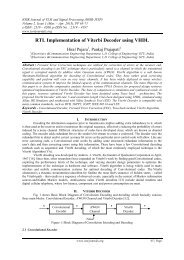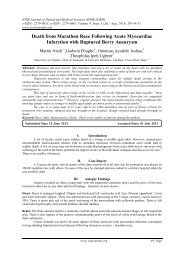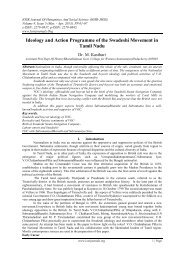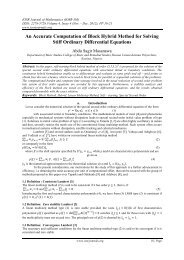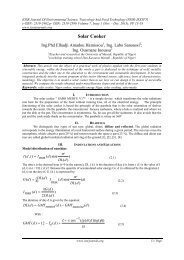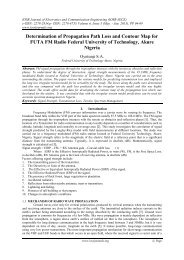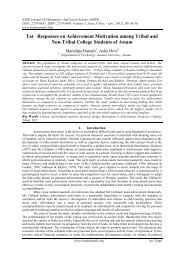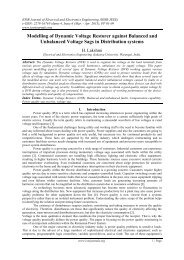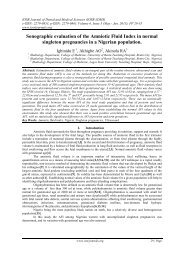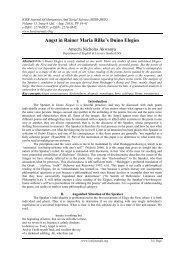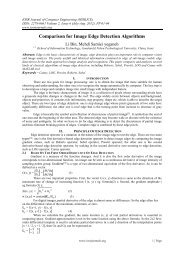Design Compatibility of Classroom Furniture in Urban and ... - IOSR
Design Compatibility of Classroom Furniture in Urban and ... - IOSR
Design Compatibility of Classroom Furniture in Urban and ... - IOSR
You also want an ePaper? Increase the reach of your titles
YUMPU automatically turns print PDFs into web optimized ePapers that Google loves.
Fuel Subsidy Removal And M<strong>in</strong>d Control Game In Nigeria: A Critical Discourse Analysis Perspective<br />
In exam<strong>in</strong><strong>in</strong>g the abuse <strong>of</strong> ideological power from the positions <strong>of</strong> Critical Discourse Analysis (CDA),<br />
we shall seek to characterize the m<strong>in</strong>d control strategies employed by the two groups to advance their sectarian<br />
positions based on implicit assumptions which are taken for granted <strong>and</strong> eventually come to be seen not as<br />
arbitrary but natural. The value <strong>of</strong> this l<strong>in</strong>e <strong>of</strong> <strong>in</strong>quiry derives from the fact that among many other resources that<br />
def<strong>in</strong>e the power base <strong>of</strong> a group or <strong>in</strong>stitution, control over public discourse <strong>and</strong> communication <strong>and</strong> by<br />
extension m<strong>in</strong>d control, is an overrid<strong>in</strong>g symbolic resource for consolidat<strong>in</strong>g social power. This is because the<br />
group who controls most <strong>in</strong>fluential discourse is equally em<strong>in</strong>ently predisposed to control the m<strong>in</strong>ds <strong>and</strong> actions<br />
<strong>of</strong> others.<br />
II. Framework<br />
CDA does not have a unitary theoretical framework, perhaps, because it is not a specific direction <strong>of</strong><br />
research, (Dijk, 1996). All the same, given the commonality <strong>of</strong> perspectives <strong>and</strong> uniformity <strong>of</strong> the aims, most<br />
k<strong>in</strong>ds <strong>of</strong> CDA will ask questions about the way specific discourse structures are deployed <strong>in</strong> the reproduction <strong>of</strong><br />
social dom<strong>in</strong>ance, whether they are part <strong>of</strong> a conversation or a news report or other genres <strong>and</strong> contexts. Thus,<br />
the typical vocabulary <strong>of</strong> many scholars <strong>in</strong> CDA will feature such notions as "power," "dom<strong>in</strong>ance,"<br />
"hegemony," "ideology," "class," "gender," "race," "discrim<strong>in</strong>ation," "<strong>in</strong>terests," "reproduction," "<strong>in</strong>stitutions,"<br />
"social structure," <strong>and</strong> "social order," besides the more familiar discourse analytical notions.' Nonetheless, our<br />
primary preoccupation here is with the theoretical aspect <strong>of</strong> CDA that relates discourse, cognition, <strong>and</strong> society.<br />
Specifically, we focus on personal <strong>and</strong> social cognition, that is, how both types <strong>of</strong> cognition <strong>in</strong>fluence<br />
<strong>in</strong>teraction <strong>and</strong> discourse <strong>of</strong> <strong>in</strong>dividual members, as well as the ways shared "social representations" govern the<br />
collective actions <strong>of</strong> a group.<br />
Dijk posits that a central notion <strong>in</strong> most critical work on discourse is that <strong>of</strong> power, <strong>and</strong> more<br />
specifically the social power <strong>of</strong> groups or <strong>in</strong>stitutions. Groups have power if they are able to control the acts <strong>and</strong><br />
m<strong>in</strong>ds <strong>of</strong> (members <strong>of</strong>) other groups. This ability presupposes a power base <strong>of</strong> privileged access to scarce social<br />
resources, such as force, money, status, fame, knowledge, <strong>in</strong>formation, "culture," or <strong>in</strong>deed various forms <strong>of</strong><br />
public discourse <strong>and</strong> communication. With regard to the fundamental issue <strong>of</strong> discursive power, CDA seeks<br />
answers to how powerful groups control public discourse; how such discourse control m<strong>in</strong>d <strong>and</strong> action <strong>of</strong> (less)<br />
powerful groups, <strong>and</strong> what are the social consequences <strong>of</strong> such control, such as social <strong>in</strong>equality? Members <strong>of</strong><br />
more powerful social groups <strong>and</strong> <strong>in</strong>stitutions, <strong>and</strong> especially their leaders (the elites), have more or less<br />
exclusive access to, <strong>and</strong> control over, one or more types <strong>of</strong> public discourse. For <strong>in</strong>stance, pr<strong>of</strong>essors, teachers,<br />
journalists, lawyers, politicians control scholarly, educational, media, legal, political discourses respectively. By<br />
implication, those who have more control over more — <strong>and</strong> more <strong>in</strong>fluential — discourse (<strong>and</strong> more discourse<br />
properties) are also more powerful.<br />
The social power, which a more powerful group has to control public discourse, equally confers on it<br />
the power to control the m<strong>in</strong>d <strong>and</strong> action <strong>of</strong> the less powerful group. With<strong>in</strong> a CDA framework, Dijk notes<br />
further that m<strong>in</strong>d control <strong>in</strong>volves even more than just acquir<strong>in</strong>g beliefs about the world through discourse <strong>and</strong><br />
communication. Draw<strong>in</strong>g from Nesler et. al. (1993), Giroux (1981), Down<strong>in</strong>g (1984), <strong>and</strong> Wodak (1987), Dijk<br />
(1993) outl<strong>in</strong>es four ways through which power <strong>and</strong> dom<strong>in</strong>ance are <strong>in</strong>volved <strong>in</strong> m<strong>in</strong>d control. First, recipients<br />
tend to accept beliefs, knowledge, <strong>and</strong> op<strong>in</strong>ions (unless they are <strong>in</strong>consistent with their personal beliefs <strong>and</strong><br />
experiences) through discourse from what they see as authoritative, trustworthy, or credible sources, such as<br />
scholars, experts, pr<strong>of</strong>essionals, or reliable media. Second, <strong>in</strong> some situations, participants are obliged to be<br />
recipients <strong>of</strong> discourse, which may need to be attended to, <strong>in</strong>terpreted, <strong>and</strong> learned as <strong>in</strong>tended by <strong>in</strong>stitutional or<br />
organizational authors. Third, <strong>in</strong> many situations, there are no pubic discourses or media that may provide<br />
<strong>in</strong>formation from which alternative beliefs may be derived. Fourth, recipients may not have the knowledge <strong>and</strong><br />
beliefs needed to challenge the discourses or <strong>in</strong>formation they are exposed to. Whereas these conditions <strong>of</strong> m<strong>in</strong>d<br />
control are largely contextual (they say someth<strong>in</strong>g about the participants <strong>of</strong> a communicative event), other<br />
conditions are discursive, that is, a function <strong>of</strong> the structures <strong>and</strong> strategies <strong>of</strong> text or talk itself.<br />
Contextually based control derives from the fact that people underst<strong>and</strong> <strong>and</strong> represent not only text <strong>and</strong><br />
talk, but also the whole communicative situation. Also, Mart<strong>in</strong> Rojo <strong>and</strong> van Dijk (1997) have shown how<br />
context features (such as the properties <strong>of</strong> language users <strong>of</strong> powerful groups) <strong>in</strong>fluence the ways members <strong>of</strong><br />
dom<strong>in</strong>ated groups def<strong>in</strong>e the communicative situation <strong>in</strong> "preferred context models". Part <strong>of</strong> CDA preoccupation<br />
is with how discourse structures <strong>in</strong>fluence mental representations. Such studies as Du<strong>in</strong> et al. (1988); van Dijk<br />
(1991), Wodak <strong>and</strong> van Dijk (2000) present empirical evidence <strong>of</strong> how various types <strong>of</strong> discourse structure may<br />
<strong>in</strong>fluence the formation <strong>and</strong> change <strong>of</strong> mental models <strong>and</strong> social representations. It follows then that if dom<strong>in</strong>ant<br />
groups largely control public discourse <strong>and</strong> its structures, they thus also have more control over the m<strong>in</strong>ds <strong>of</strong> the<br />
public at large. Nonetheless, such control is not without its limits. This <strong>in</strong>forms Dijk‘s observation that ―the<br />
complexity <strong>of</strong> comprehension, <strong>and</strong> the formation <strong>and</strong> change <strong>of</strong> beliefs, are such that one cannot always predict<br />
which features <strong>of</strong> a specific text or talk will have which effects on the m<strong>in</strong>ds <strong>of</strong> specific recipients.‖<br />
www.iosrjournals.org<br />
7 | Page



